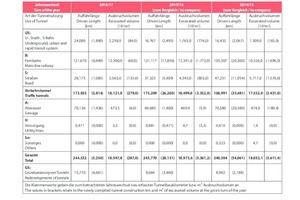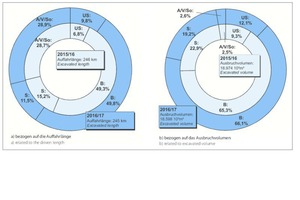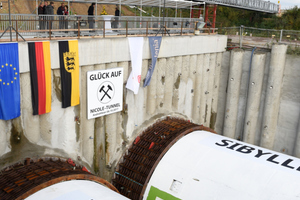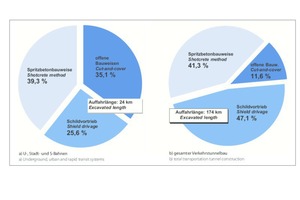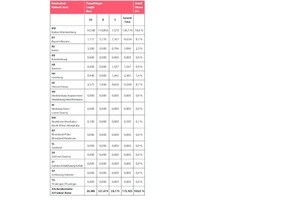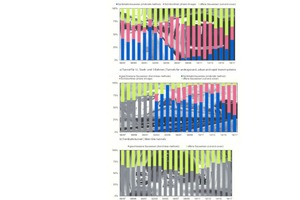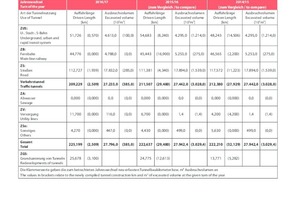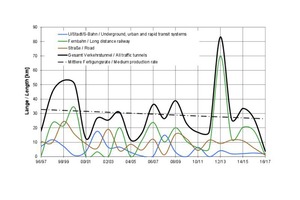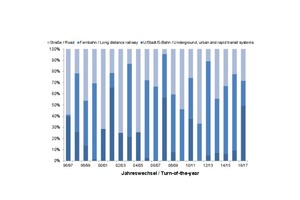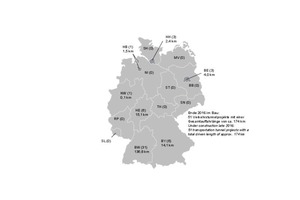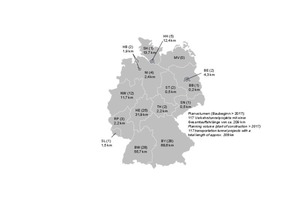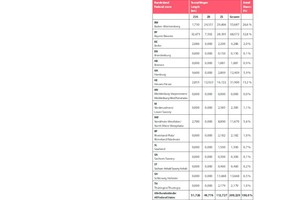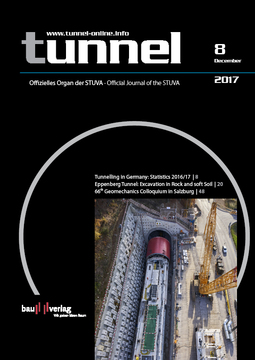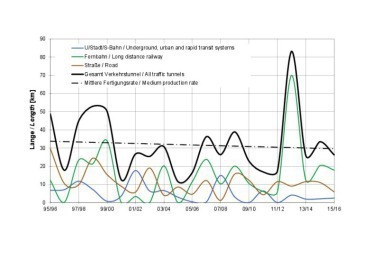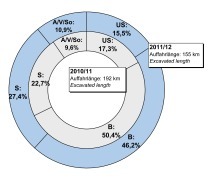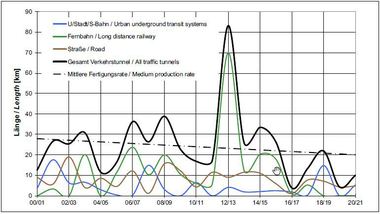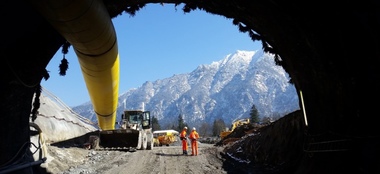Tunnelling in Germany: Statistics (2016/2017), Analysis and Outlook
For more than 35 years the STUVA has carried out a survey of tunnelling in Germany prompted by a corresponding request by the International Tunnelling and Underground Space Association [1].
1 Tunnels under Construction
As in previous years, the STUVA also undertook a survey of current tunnelling projects in Germany at the turn of the year 2016/2017. The outcome is compiled in tabular form for the month of December 2016 and subsequently assessed. The table follows up its predecessors published for the years 1978 [2] to 2016 [3]. Only tunnels and drain/sewer structures which possess an accessible (walk-in or crawl-in) excavated cross-section, i.e. a clear minimum diameter of 1000 mm or, including the pipe wall, a minimum cross-section of roughly 1 m2, are listed. As in previous years, small trenchless headings which have been executed in conjunction with main drain construction, the relevant domestic connections, and also pipe-jacking operations beneath rail and road facilities, are not included.
The tables for the tunnel projects under construction at the turn of the year 2016/2017 are not listed in detail on account of their extent; however data can be obtained from STUVA’s internet pages [4]. In these tables, the numbering of the tunnel projects indicates the relationship to the data material originating from previous years. Essentially it takes the form of single or double identification letters, a two-digit sequential registration number and a two-digit annual identification number. The identification letters serve to provide a brief assessment of the planned tunnel utilisation, namely:
US Underground, urban and rapid transit rail tunnels
B Main-line rail tunnels
S Urban and trunk road tunnels
V Water and other supply tunnels
A Drain/sewer tunnels
So Miscellaneous tunnels
GS Tunnel modernisation
The identification number US 0116 therefore refers to a tunnel project with the sequential number 1 from the Underground, urban and rapid transit tunnels sector which was included for the first time in the statistics in 2016. The above-mentioned method of identification was selected against the background that the majority of construction sites, especially those from the transportation tunnel sector, run for two or three years, or even more. This method of registration has proved itself in order to avoid projects being counted twice and to identify the new construction volume that was to be included. As a result, Table 1 contains the total construction volume as well as the construction volume collated during the year of the report, set in brackets. In addition to the details for the turn of the year 2016/2017, the figures from the two previous years can also be found there for comparison.
By and large, the tunnel lists on the STUVA internet pages [4] provide information on the location and ultimate utilisation of the tunnels that are included, their length and cross-sections, and also the soil conditions mainly encountered. The construction method used is explained in brief and the scheduled construction time stated. As far as possible, the clients, designers and contractors are named. Details of constructional or technical aspects of a special nature are also provided for many projects.
When comparing transportation tunnels with supply and disposal tunnels, information on the excavated volumes of the individual schemes makes it possible to estimate the actual extent of the relevant measures in a better manner than mere details relating to lengths. However, the following should be observed when comparing the excavated volume: whereas the excavated volumes for trenchless construction measures can be determined with certainty, the comparative value for cut-and-cover methods can only be obtained by subtracting the amount of soil required for refilling from the total excavated volume.
Table 1 provides a picture of the overall tunnelling length under construction at the end of the year in question and the related construction volume. For the turn of the year 2016/2017, Fig. 1 also contains the driven length and the excavation volume in accordance with the type of tunnel utilisation, shown in graphic form.
A general comparison of the figures in Table 1 reveals an unchanged high level in the driven length of transportation tunnels as at the turn of the year 2016/2017, with a total of some 174 km. Whereas building activities in the main-line construction sector remained largely at the level of the previous year, activities in Underground, urban and rapid transport revived substantially whilst road construction once more dipped considerably.
If one considers the data relating to excavated volume, there is a length-related ratio of almost 2,5:1 as against a volume-related one of around 38:1 when comparing transportation tunnels on the one hand with supply and disposal tunnels on the other (please also see Fig. 1).
The question of the completeness of the data obtained from the STUVA survey from contractors and consultants is difficult to assess. In order to arrive at greater reliability in this respect, the cities engaged in Underground, urban and rapid transit construction activities, and also Deutsche Bahn AG, were requested to supply data within the scope of the 2016/2017 survey, as was the case in previous years. The Federal Ministry of Transport and Digital Infrastructure (BMVI) provided data for federal trunk road tunnels [5]. This data is an essential part of the annual update of the statistics and provides important additions and corrections. At this point, a special word of thanks goes to the Federal Ministry of Transport and Digital Infrastructure, Deutsche Bahn AG, the other authorities and clients mentioned and the engineering firms and contractors involved, for their assistance in compiling the statistics for current tunnelling projects.
In the following, the results of the survey as of December 2016 are evaluated more thoroughly in various ways in order to obtain an up-to-date overview of tunnelling in Germany. In order to substantiate this, please refer to the comprehensive explanatory notes relating to the structures to be found in ”Underground Construction in Germany 2010”, containing a large number of examples presented in both illustrated and written form [6].
As in the previous year, the main activities relating to inner-urban rail tunnelling (Table section US) are taking place in Stuttgart, where some 9.7 km of urban and rapid transit tunnels are under construction at the turn of the year 2016/2017.This is followed by Karlsruhe (4.7 km), Frankfurt/Main (4.4 km) and Berlin (3.2 km). Further tunnel projects amounting to less than 2 km are underway in Dortmund, Hamburg and Nuremberg.
The length-related proportion of trenchless construction methods with regard to inner-urban rail tunnel construction amounted to 15.6 km at the end of 2016, accounting for about 65 % of the total national construction volume for Underground, urban and rapid transit rail systems (48 % the previous year). Of this total, almost 39 % was accounted for by shotcreting methods (22 % the previous year) and roughly 26 % (as in the previous year) by shield driving. Fig. 3a provides a survey of the percentages accounted for by the various tunnelling methods. In this context, the diagram in Fig. 4a shows the length-related proportion of the different construction methods in Underground, urban and rapid transit rail construction during the last 20 years.
The main-line rail tunnels listed in table segment B largely relate to works in the greater Stuttgart area (Fig. 2). Of the tunnelling projects currently being implemented (a total of 122 km) some 47 km are accounted for by the major project “Stuttgart 21 rail hub” and some 59 km by the new Wendlingen–Ulm rail route. Further main-line tunnels are being constructed in conjunction with the upgraded/new Karlsruhe–Basle section and the upgraded Hanau–Nantebach line. 35 % of these main-line rail tunnel projects employ the shotcreting method, with tunnel boring machines (TBMs) used for a further 61 % of the current excavated volume (please also see Fig. 4b).
Road tunnel construction (section S of the table), like the two other transportation tunnel segments, has been subject to pronounced contracting fluctuations in recent years. This becomes clearly evident from the award curve in Fig. 5 and above all, from the graphics pertaining to the award and length-related percentages of the different modes of transport in Fig. 6. The ratio of road tunnels built by trenchless means and by cut-and-cover stands at roughly 3:1 (please see Fig. 4c). In this connection, shotcreting predominates in the majority of cases as far as trenchless projects are concerned.
In the V and A sections of the table, relating to supply and disposal tunnels, only those of larger diameter – as initially explained – are listed. The smallest cross-sections dealt with are roughly 1.0 m in diameter, the largest around 3–4 m. All the supply and disposal tunnels processed at the turn of the year are driven by trenchless means. In the case of wastewater disposal tunnels, pipe-jacking continues to prevail as it has in previous years. Furthermore, in compiling drain/sewer statistics, it should be pointed out that only main drains are included here. The considerably greater part accounted for by drains with smaller cross-section, mostly driven close to the surface by means of cut-and-cover, is not listed here, as this is generally not classified as tunnelling.
Table 2 and Fig. 7 provide details of the regional distribution of ongoing tunnelling projects. At present round 3/4th of the volume of tunnels being built nationally on the transportation tunnel sector is accounted for by the federal state of Baden-Württemberg.
If one compares the newly obtained driven lengths and excavated volumes at the turn of the year for transportation tunnels based on the statistics of recent years, this provides a revealing picture of just how contracts are awarded. In this connection, Fig. 5 clearly shows the important influence of the DB’s upgraded/new lines and displays the continuing fickleness on the part of public authorities in awarding new tunnelling contracts. With regard to main-line tunnels, following a steep increase in awarding contracts (mainly on account of the commissioning of “blocks” for the DB high-speed routes) the ensuing years experience an equally pronounced dip (please refer to Fig. 6). Fig. 5 also displays the average annual “completion rate”, which amounts to around 30 km for all transportation tunnels over a period of 20 years.
2 Planned Tunnelling Projects (Future Requirements)
The results of the survey relating to confirmed tunnel projects and those due to be awarded in the near future are naturally of special interest to the construction industry and consultants. Table 3 shows the award period starting in 2017.
Examination of the data in Table 3 clearly indicates that the planning volume for transportation tunnels has shown a further decrease, among other things due to the described fluctuation in the awarding process.
There has again been a slight decrease in the number of Underground, urban and rapid transit tunnels . In this context, the planned volume for the city of Munich, comprising just about 30 km, is conspicuous among the projects still planned. Almost 10 km of tunnels are being planned for the Hamburg Metro (partly at the pre-planning stage). Further tunnel construction schemes, albeit accounting for less than 3 km in each case, are scheduled for the cities of Frankfurt/Main, Nuremberg, Berlin, Düsseldorf, Stuttgart and Dortmund.
Regarding the planned volume of main-line rail tunnels, it should be noted that roughly half of it is accounted for by the tunnels approved for the new/upgraded Karlsruhe–Basle rail line (excavation length: some 19 km). Some 8 km of tunnels are planned in conjunction with the new Rhine/Main–Rhine/Neckar route and the Nuremberg–Fürth route. A further 5 km of main-line tunnels are still to be awarded for the Stuttgart 21 rail hub project.
The planned volume of projected road tunnels remains largely unchanged in comparison with the previous year. On account of the German state’s revamped planning requirements, the scheduled volume has dipped considerably in recent years.
The 113 km of planned road tunnels listed in Table 3 have at least generally reached the planning approval stage. This applies principally to the tunnels on federal trunk roads, i.e. those for whose construction the federal government is responsible.
Technical details relating to the tunnels contained in Table 3 are available from the relevant detailed tables [4]. Essentially, these are structured in the same manner as the statistics on tunnel projects which are in the process of implementation, as presented in chapter 1. The same approach was selected to identify and differentiate the individual tunnel projects. However, the letter “Z” (zukünftig) has been added to make quite clear that the tunnel construction scheme in question is a “future” one. As a consequence, no details are provided concerning the responsible construction companies, whereas these can be found in the statistics on current tunnel projects.
Generally speaking, as far as assessing the detailed data relating to future tunnel projects is concerned, it must be observed that alterations can occur during the planning approval and award stages, above all, due to special proposals, relating primarily to the tunnelling method. Various clients expressly pointed this out. Alterations can of course also result with respect to the probable starting and completion dates for projects.
It is also of particular interest for the construction industry and the consultants involved to be aware of the regions for which implementation of the planned tunnel projects is mainly scheduled. Table 4 and Fig. 8 show the relevant details, categorised by federal states.
3 Current and future Tunnel Modernisation Plans
To an increasing extent, partial and complete refurbishing schemes are now being scheduled for old rail tunnels in the years ahead. Generally speaking, such measures call for special organisational and logistical provisions, particularly if these projects are to be implemented without causing disruption to rail traffic [7]. Recent examples of this are provided by the complete renovation of the Frauenberg and Kupferheck tunnels on the Nahe valley line between Bingen and Saarbrücken as well as the Langenau and Hollerich tunnels on the Lahn valley line between Wetzlar and Niederlahnstein at Nassau. These lines were originally opened in 1860 and 1862 respectively. In the near future, comprehensive modernisation of some 14 km of tunnel is scheduled in addition to the around 12 km already being accomplished.
Refurbishing measures are increasingly becoming more essential for road tunnels as well, first of all to protect the basic structure, quite apart from complying with operational and safety technical requirements. This can involve replacing the concrete for the inner lining or subsequently adding an evacuation or rescue tunnel [8]. At the time of the survey roughly 4 km of road tunnels were in the process of being redeveloped or retrofitted. Modernisation or retrofitting of a further 12 km or so of road tunnels has been definitely planned.
Details on ongoing renovation schemes are compiled in the table section “GS” or “ZGS” relating to scheduled renovations.

